
Abel Sierra Madero, Hypermedia Magazine, 15 May 2020 — Yuri Brokhin, a Soviet filmmaker who defected in 1972 and settled in the United States, described his experience trying to purchase a Volga automobile in the late 1960s. In all of Voroshilovgrad, Ukraine, there were only twelve of these cars available for sale to the public, but they were already reserved for soccer players. One police commissioner, who wanted to “enter” History, told Brokhin that if he made a film about his department’s accomplishments, he could help him with the matter of the car.
“We must show the Soviet people…. what a modern correctional camp is like,” he recommended. [1]
Lights, Camera, Action…
Given the enthusiasm with which the police commissioner described it, Brokhin said, it was possible that the Soviets were choosing their vacation destinations wrongly. It was much more pleasant to go to a forced labor camp.
When the crew arrived at the Voroshilovgrad Oblast gulag, which was dedicated to building boilers for locomotives, they found at the entrance, tied to the barbed wire fence, a sign with the inscription: “Labor turned the Ape into Man – Friedrich Engels.” [2] The filmmaker was astonished, but his thoughts were only of his Volga. continue reading
Since the idea was to show the “miracle” of the forced labor camp, they filmed several detainees, including Sidorov, who was charged with armed robbery. In a colorful and romantic scene, Sidorov stopped working and greeted the commissioner with a warm handshake. Immediately, he and other inmates protested and asked why they had not received additional ideological materials to read, for example, the five volumes of speeches by Leonid Brezhnev, the leader of the Supreme Soviet, and more books by Marx and Lenin.
The film crew also took some shots of the residential area of the camp. In these scenes, some barracks looked impeccable, its lawn green and freshly trimmed. It was likely, Brokhin reflected, that the facilities were in good shape because there were no political prisoners, or perhaps these were set for propaganda and public relations purposes.
In the film one of the wardens introduced on-camera the enthusiastic comrades, who spoke of the miracle of re-education. Among them was Savchenko, a.k.a. Pot, who was announced as an “ex-thief and active homosexual.” “Citizens, for the first time in my life, I understand what a collective is. Thanks to the collective, I have become a changed man,” said Pot. [3] According to Brokhin, several around Pot muttered, “Yes, yes, he’s changed from active to passive.” [4]
Other speakers criticized US imperialism and called to increase production levels. The film ends with the hymn, “The Party is our Guide,” by the Soviet composer Vano Muradeli. The police commissioner kept his word, and by the end of 1967, Yuri Brokhin was driving his Volga.
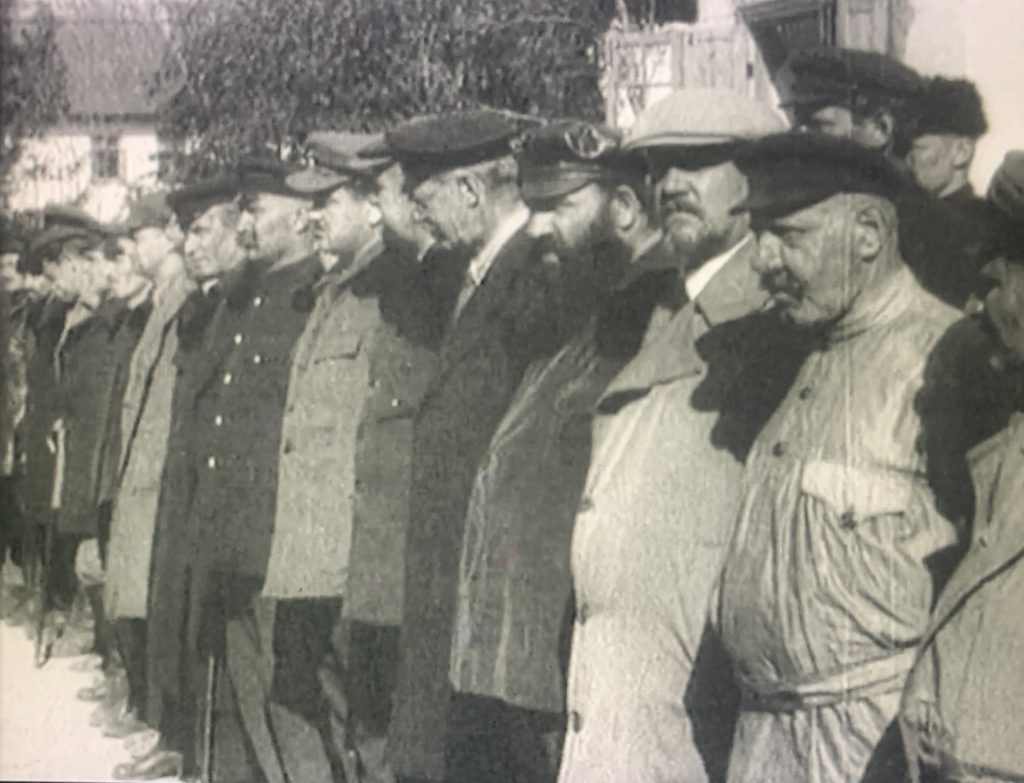
Yuri Borkhin was not the only one involved in the project of changing and exporting a positive image of the gulag, even Eisenstein himself participated as well as other artists, photographers, painters and writers, including Maxim Gorky.
In 1934, the playwright edited – along with S. G Firin (Semen Georgievich) and Leopold Averbach, a critic who was shot in 1938 – Belomor, The “Stalin” Channel Between the Baltic and White Seas: An Account of Its Construction. This was a volume commissioned by the secret police (GPU) to produce a positive memory of the gulag. Several writers and inmates participated in the project, which, in a tone of self-criticism, praised the policy of reeducation and the role of the political police.
But the representation of the gulag as a resort had already been attempted in Solovki, a 1928 picture directed by Aleksandr Cherkasov, whom the GPU had commissioned to produce a propaganda film. The material was part of a strategy to counter the allegations of Sergei Malsagov, who had escaped from the Solovki prison camp and was making statements to the English press.
The vision of Cherkasov’s film has nothing to do with horror. On the contrary, in it the filmmaker portrays a “model” camp, in which the viewer can appreciate comfortable accommodations, delicious food and even cultural attractions: theater, variety shows and concerts. The Solovki gulag portrayed in the film also boasted a museum, a newspaper, a school, and a library. And, of course, we can also see young people taking a dip in the lake after work or playing sports.
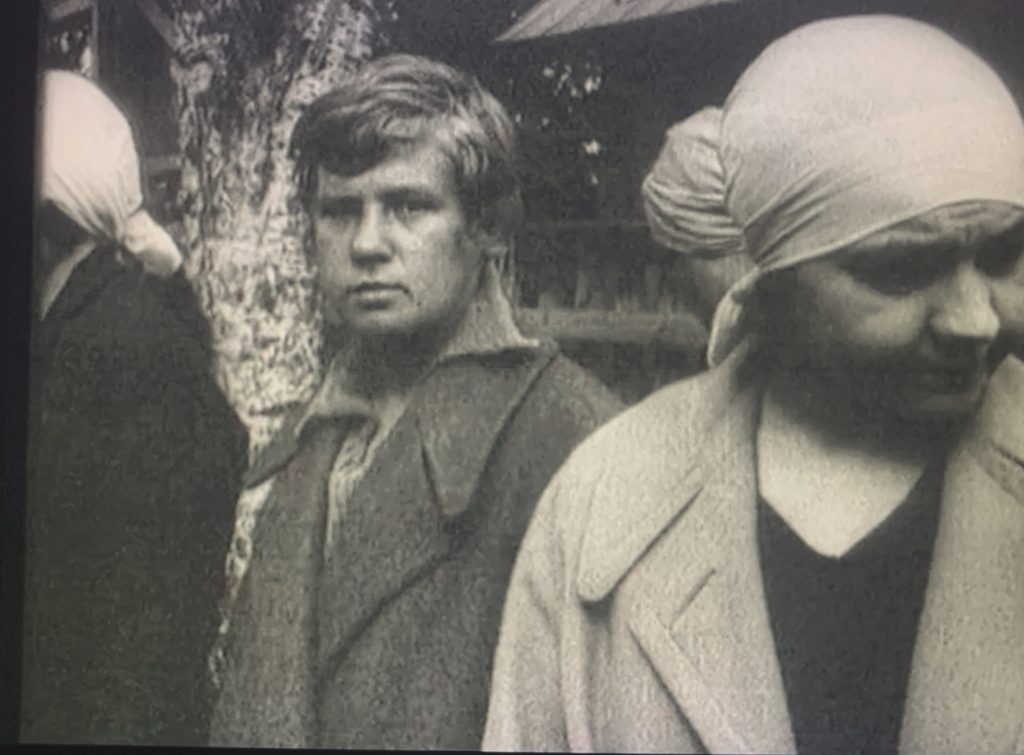
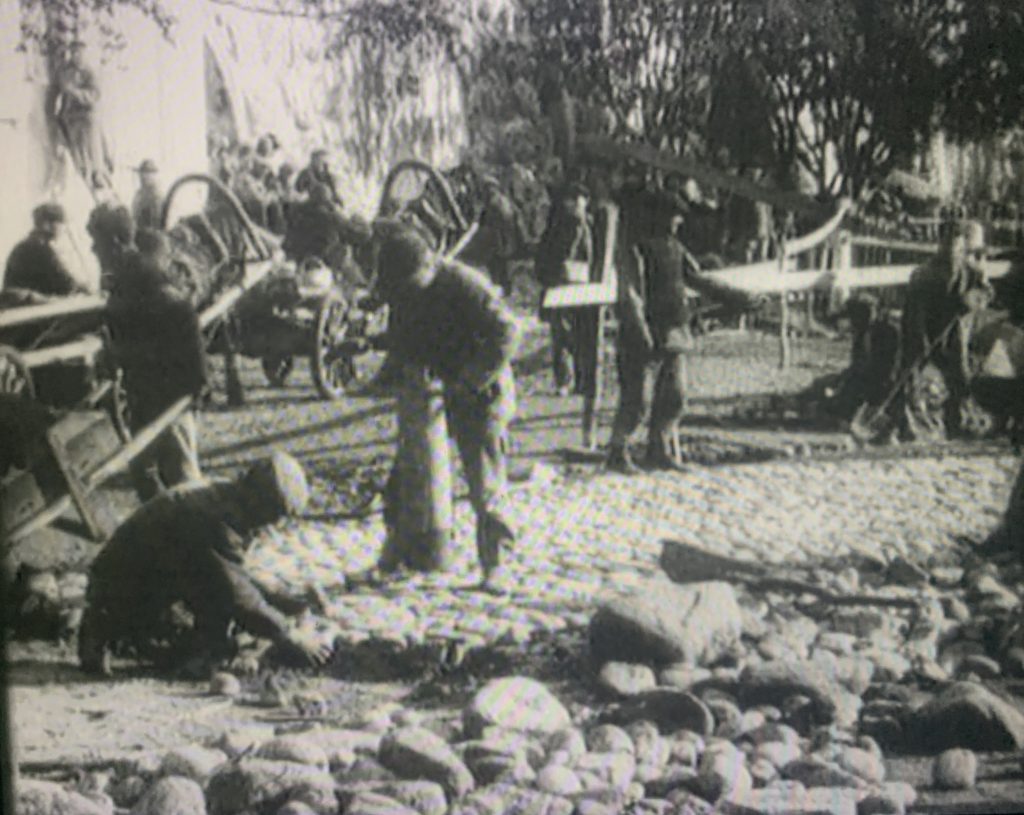
The Solovki, or Soloviets camp was located in the premises of a former cloistered monastery. At the entrance was a banner with huge letters, which stated a cordial welcome: “With an iron hand we will lead humanity to happiness.” [5]
Cherkasov’s film is at once pleasing and terrifying, with a clear, example-making message for the enemies of the Soviet state. The film narrates the tortuous and long cycle of rehabilitation. “Spies, speculators, thieves, bandits, those who disturb order, and counterrevolutionaries are sent to the Solovki Islands, in the White Sea,” explained the written narrative of the film. [6] According to Alexandr Solzhenitsyn, religious envoys, including Orthodox monks, prostitutes, and intellectuals – such as Dmitri Likhachov and Pavel Florensky – were sent to Solovki. [7]
The camp’s mission, as clarified on a poster, was to “create work habits and re-educate socially harmful persons to turn them into useful members of society.” [8] Some administrative details are given in the film. “Those who resist education through work are transferred to a punishment section on Sekirnaya Mountain,” it warns. [9] In a military-type formation or parade, inmates are ironically described as the “trash” of society, term proper to communist biopolitical jargon.
The scenes depicting the massive transfer on trains of people escorted by the military with long weapons are overwhelming. The choreography of inmates in a boot factory, the composition of machines, forges, lathes, and agricultural laborers picking and shoveling amid the speed and quietness of “silent” cinema, create an even more oppressive ambience. A herd of aligned pigs became the image of the inmates.
The UMAP We’ve Been Taught and the Control of Memory
In Cuba, the history of the Military Units to Aid Production (UMAP) has also been camouflaged and distorted by official narratives. But unlike the Soviets, who saw cinema and literature as instruments to wash the memory of the gulag, the leaders of the Cuban Revolution did not take such risk. The installation of those infamous forced labor camps, between 1965 and 1968, was managed as a state secret. But when the atrocities and abuses began to generate an international panic over the authoritarian symptoms that the Revolution was showing, the strategy changed. Then a policy of damage control was developed, aimed at constructing a different public memory of the concentration camp.
I will not dwell on the details of the structure, design and organization of the UMAP, nor on the punishments. This essay has a different objective. In 2016 I made a couple of contributions to the topic that readers can access. These are “Academies to Produce Macho Men in Cuba,” an article that was published by Letras Libres magazine, and “‘Work will make you men’: National masculinization, forced labor and social control in Cuba during the sixties”, a slightly longer essay published in issue 44 of the academic journal, Cuban Studies.
The government’s damage control policy toward the UMAP, was based on the construction of narratives about economic success and the “miracle” of forced labor camps as an educational model. Adelante, the newspaper of the province of Camagüey, was one of the platforms from which attempts were made to manage the memory of the UMAP. It was in that region that most of the units were installed.
The campaign began on the recommendations of Raúl Castro himself. On April 9, 1966, a few months after the camps were put in place, Castro visited Camagüey and spoke with some journalists. “I don’t know if you will have time to do a little reports on the UMAP out there.” [10] Immediately, a journalist alleged: “The problem is that there is no authorization to report about the UMAP.” [11]
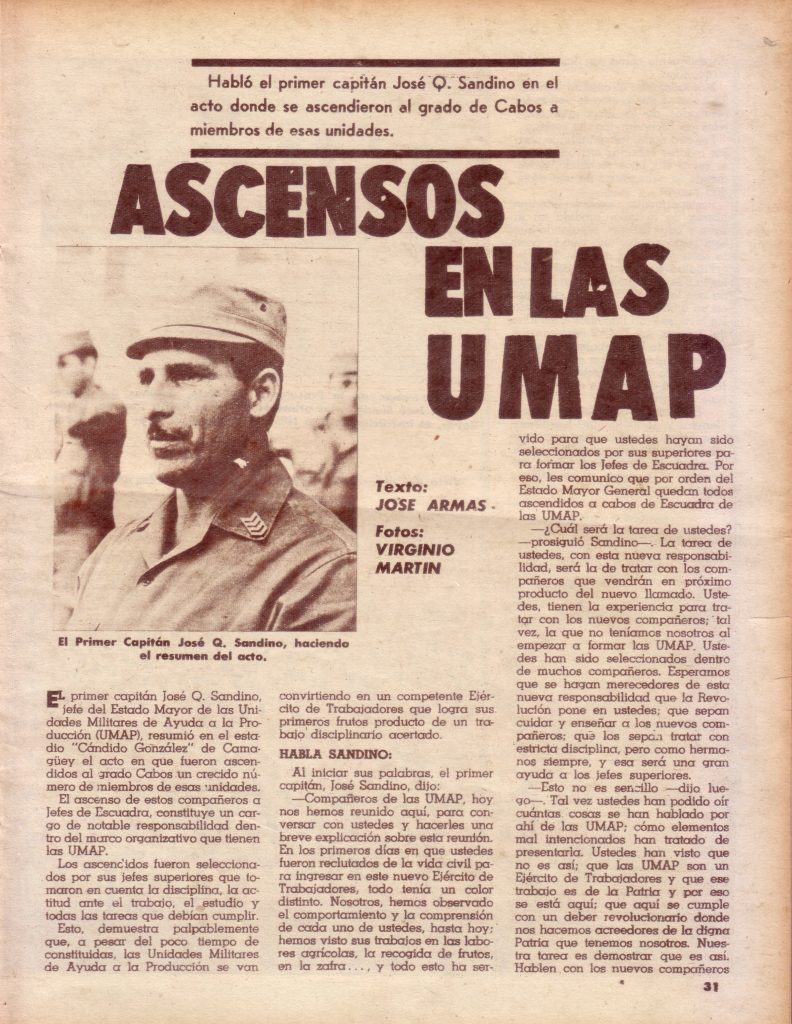
Apparently, the journalists received the authorization, because the “little reports” that Raúl Castro requested started coming out a few days later. On April 13, 1966, the journalist Luis M. Arcos published in the pages of Adelante a pamphlet in which he affirmed – using language typical of manuals of Marxist-Leninist philosophy – that the UMAP had a formative, educational character, and that they played “a very important role in the radical transformation of the nation.” [12] He also said that the camps had been created for the welfare of society, and that they were the subject of “continuous speculation by counter-revolutionary elements.” [13]
These contents, published in the state-controlled media, are far from a model of investigative journalism. They are generally written for propaganda purposes. The curation of the images and quotations tacitly support the official account.
The Revolutionary Armed Forces (FAR) and its press organs also sold the idea that inmates with high productivity in cutting sugar cane were rewarded with material goods. On October 30, 1966, Verde Olivo magazine published a note with some photographs, which gave the assurance that the “comrades” had been compensated with motorcycles, refrigerators, radios and watches.
It is likely that the awards ceremony was a staged as public relations event. The text quoted a short speech by José Q. Sandino Rodríguez, chief of the UMAP General Staff, in which he assured that the ceremony “once again disrupted the string of lies rolled out by the enemies of the Revolution”, who tried to present it as a “punitive institution”. [14]
In one of the passages in his book, After Captivity, Freedom: A Real-Life Account of Castro’s Cuba, Luis Bernal Lumpuy refers to the disguise exercise the guards carried out in the facilities of his unit, when they expected visits from the press. He also talks about the “performance” that they were forced to do every time this happened.
In the spring of 1966, Bernal Lumpuy wrote that they received a visit from Commander Ernesto Casillas, then head of the UMAP General Staff, who came with journalists and cameramen. They brought baseball gloves, bats and balls, and distributed them among the inmates. “They had such a hearty lunch that it later affected the health of the starving prisoners, and they prepared an event in the camp for the commander to speak.” [15] Casillas promised family visits, “as if that were a generous act of the Revolution, and he even lied when he said that we would be given permission to go to our homes that month, which did not happen until months later.”
They had arranged, concludes Luis Bernal Lumpuy, for the cameras to capture “the enthusiasm of some who lent themselves to the propaganda game.” A few days later “the press, radio, and national television showed groups of youth from the UMAP carrying Commander Casillas on their shoulders as though he were a hero.” [16]
As part of the campaign that I have been describing, the Army decided to choose some of the inmates and grant them military ranks. They were awarded the title of “corporals”. This strategy sought to establish in public opinion the notion that the UMAP were not concentration camps, but rather military units. According to the testimony of José Caballero Blanco, some commanders “were abusive in exchange for perks. This is nothing new, if you consider that there are jails that use some prisoners to repress their colleagues.” [17]
Indeed, in other concentration camp settings, it was very common for the wardens to use inmates to suppress their peers and do the dirty work. In Nazi camps, for example, there was the sad role of the Sonderkommandos: Jews put in charge of aiding the machinery to exterminate their own people. However, the category of Kapos (or Funktionshäftlinge), is more in line with the squadrons that were created in the forced labor camps in Cuba. In the gulag they were known as “foremen” (nariádchik).
Within the CENESEX, everything – against the CENESEX, nothing
I have explained this on several occasions, but I think it is necessary to say it again. For some years now, we have seen a series of mutations taking place in the Cuban regime aimed at guaranteeing the continuity of the system and erasing the past. I call this process of political shapeshifting, “State transvestism” and it consists in a readjustment of Cold War revolutionary rhetoric – using the notion of diversity in an instrumental way to offer an image of change for foreign consumption – when in fact very few changes have been made. [18] This strategy began to be tested a decade ago by the National Center for Sexual Education (CENESEX), directed by Mariela Castro Espín, the daughter of General Raúl Castro.
The notion of “transvestism” is based on a reading of the State as a porous, fluid body, and not as a rigid and immovable structure. I use it mainly to describe the masquerades, camouflages, and appropriations that official institutions make of the practices and “performance” of the transvestite and their milieu. “State transvestism” is, therefore, a project of de-politicization and assimilation, aimed at producing certain bodies and subjectivities, as well as controlling their political and cultural history.
This project, besides testing new modes of political control, promotes an amnesic transition, a washed-out national memory, and the rewriting of History. The idea is to rearrange and rewrite certain historical processes that connect the Revolution with discrimination and homophobia.
For decades, homophobia in Cuba was a state policy that legitimized the purges of homosexuals from institutions and the establishment of forced labor camps, designed to build the communist “new man”.
Mariela Castro has tried to minimize the scope and dimension of the UMAP in the History of the Cuban Revolution. She even promised an investigation on this topic. We are still waiting for it. Since then, the director of CENESEX has stated in many appearances and interviews that the UMAP constituted an isolated error and were not in any way forced labor camps.
Mariela Castro recently did it again and provoked in the midst of the novel coronavirus pandemic, multiple and bitter controversial reactions. It occurred during an online broadcast, where she used biopolitical terms and the language of animality against critics, calling them “cheap trinkets” and “tics”. One more term to add to the large repertoire of hate and intolerance discourses designed to attack and dehumanize those who dissent or think different.
Comments on social media exploded instantly. “Everything within CENESEX, nothing against CENESEX,” some answered, in frank allusion to the 1961 speech delivered by the late Fidel Castro, which became known as “Words to the Intellectuals”.
A few days ago, Mariela Castro was invited to La tarde se mueve [Afternoon Moves] a show hosted by Edmundo García on YouTube. The activist is known for his affection for the Cuban regime, even though he lives in Miami. It is not by chance that Castro Espín used this platform to talk about the UMAP. Her statements coincided with the fact that the documentary, Pablo Milanés, produced in 2016 by Juan Pin Vilar, became available to the public. The film was censored in Cuba and was restricted on Vimeo until now. There, Milanés talks briefly about the UMAP, where he was sent in 1966, when his musical career was taking off.
“Although there is no comparison, I can tell you that I was at Auschwitz and the facilities were better than those of the UMAP (laughs). The facilities were scary,” he said. Auschwitz is a superlative representation of horror that ex-UMAP inmates have used repeatedly. However, this analogy has produced serious consequences for the legitimacy of their narratives, because, among other things, there were no crematoriums or gas chambers at the UMAP. This exercise must be understood within a strategy aimed at locating their experiences within a universal story, on a global map of concentration camps.
In the film, Pablo Milanés says that while in the UMAP, he suffered from Stockholm syndrome. Along with the actor Ricardo Barber, a play was produced and performed in their unit. This is how he describes it: “We did a work that favored those who had sent us there and blamed ourselves for having gone there. We felt guilty, because every day they told us, ‘you are trees that have grown crooked’.” Apparently, the guards were pleased and proposed that we perform it in other camps. “Barber and I tore up the play and said we didn’t remember it and that we didn’t want to do it anywhere. We had been rendering tributes to those who sent us there,” he concluded. Ricardo Barber left Cuba in the 1970s and went to New York, where he died in late 2018.
For some time after leaving the UMAP, Pablo Milanés became one of the icons of the Nueva Trova movement. His songs, along with those of Silvio Rodríguez, among others, formed the soundtrack of the Revolution that influenced millions of people. Although in Cuba it was an open secret that Milanés had been sent to the concentration camps, Pablo waited several decades to discuss the matter.
Until Juan Pin Vilar’s documentary came out in 2016, the singer-songwriter had limited himself to giving just a few details to foreign journalists who interviewed him during his international tours. The few bites of information he provided regarding his experience in the UMAP always coincided with the promotion of his concerts in Latin America.
It is possible that the Stockholm syndrome of which Pablo Milanés speaks has affected him for a long time. In 1984, almost twenty years after leaving the UMAP, he wrote, “Cuando te encontré [When I Found You]”, a love song to the Revolution that advocates: “It would be better to drown in the sea than to betray the glory we have lived.” In addition, there are indications that in 1980 he participated, along with other members of the Nueva Trova, in a repudiation rally against his colleague Mike Porcel.
“The release of this documentary and the statements of Mariela Castro Espín in La tarde se mueve are connected. In what seems like a response to Pablo Milanés, the director of CENESEX tried to downplay the UMAP. To give it a little opacity, she said that the UMAP is an “exaggerated and distorted issue.” Although she acknowledged that “the process of arresting civilians was terrible,” she justified the settlement and installation of the forced labor camps: “There were people who were totally distanced from the country’s problems and did not want to do their bit.”
In addition, for obvious reasons, she blamed the raids and arrests on the Ministry of the Interior (MININT) and not on the Ministry of the Armed Forces (FAR), an institution that her father, General Raúl Castro, was then leading. “That was a job that was done from the Ministry of the Interior (MININT), it was not compatible with what the Armed Forces had decided,” she assured. This way, she not only deforms collective memory, but also exempts the culprits of the experiment from responsibility.
According to Mariela Castro, the experience of the inmates in the forced labor camps depended on the circumstances of each location. “At the UMAP there were “managers” [officers] who were not homophobic, and who treated their people well, and who were understanding,” she added. I will return to this later.
In another part of her remarks, the chair of CENESEX continued the practices of accommodating traumatic experiences and the falsification of History. She referenced the Escuela al Campo [Schools in the Countryside] program developed by the revolutionary leaders in the mid-1960s. “We went to Schools in the Countryside. Was going to a School in the Countryside the same as being in concentration camps? We certainly learned a lot and we had a lot of fun and we questioned everything. We had a great time…” she said sarcastically. If these discourses are accepted, it is possible that in the near future we will see the UMAP represented in school textbooks and in the public sphere as simple summer camps or vacation destinations.
As is known, the “Schools in the Countryside” program, begun in 1966, was connected to the project of creating the “new man”, and thousands of children and adolescents were sent to work in agriculture on a compulsory basis. While intensifying pedagogy of indoctrination, the state seized the workforce without providing any economic compensation. This policy was extended across the country for several decades, until the official press announced its end in the summer of 2009.
When I was a teenager I went to a School in the Countryside where I worked the fields and no, it was not a pleasant experience. I always saw it as an absurd, authoritative, and not at all fun imposition. Standards had to be met, and I often felt the hardship of hunger. There were consequences if I refused to work, and I immediately fell under suspicion. The allocation of scholarships or university admissions was subject to my performance as a farm worker.
Castro Espín’s comments try to connect that experiment to a field of affect. Within this logic, forced labor was a kind of carnival, a space of entertainment. We had already seen this type of gesture in the music of singer songwriter Frank Delgado. In the song “Maletas de Madera” [Wooden Suitcases] (2007), the Schools in the Countryside program is represented in a nostalgic dimension, and those years are made into an object of desire. This gaze has consequences for the memory it generates. The latrines, the red soil, and hunger, gained very positive connotations and depoliticized the experience itself. The catchy tune went something like this. “Vamos a formar, una conga, con maletas de madera, tomando agua con azúcar encima de una litera” [“Let’s make a conga with our wooden suitcases, let’s drink water with sugar on top of our bunk beds”].
The most problematic area of Mariela Castro’s comments in La tarde se mueve has to do with her concept of History. According to Castro Espín, historians must stop “picking through the garbage with bad intentions.” This eschatological notion deployed by the director of CENESEX represents researchers as ill-intentioned “garbage collectors”, and History as a discipline that belongs exclusively to the past. It is aimed that the official History of the Revolution be established as a fixed and incontestable narrative. But as writer Reinaldo Arenas would say, Ah, how the shit sizzles when it is stirred. [19]
“The Hour of the UMAP”
State transvestism as a political strategy is also based on the creation of spaces for controlled criticism in which certain discourses are tolerated, as long as they do not endanger the hegemony of the State. These spaces are used systematically to promote certain narratives about the Revolution that guide how some complex historical issues, such as the UMAP, should be read and assimilated.
In November 2015, on the fiftieth anniversary of the installation of these forced labor camps, the Christian Center for Reflection and Dialogue-Cuba, an institution that seeks to reform the battered Cuban socialism, held a meeting in Cárdenas, Matanzas province, of ex-inmates from the UMAP to discuss the subject.
Several of those attending the event recounted details of their experiences in the forced labor camps and referred to the mistreatment and abuse to which they were subjected by the guards. “I felt disgust for my country,” said Moisés Machado Jardines then. [20] “Because of having been in the UMAP, I was marginalized from my old job and others that I tried to get when I got out, and I even lost my wife, who left with my two children.” [21]
Rafael Hernández, director of Temas, a Social Sciences journal that functions as a space for controlled criticism “within the Revolution”, also participated in the Cárdenas meeting. His contribution was aimed at accommodating and diluting the injustices of the UMAP within Cold War rhetoric. “It is not just about evaluating the justice or effectiveness of those measures, but remembering the historical context in which they were developed,” he said. [22]
Days later, in the Temas blog Hernández published: “The Hour of the UMAP: Notes for a Research Topic”, where he proposed a very particular reading of the forced labor camps in Cuba, and set forth how they should be investigated. For the intellectual, the UMAP were a sort of “re-education schools” – or at the least, “punishment camps” – but not forced labor camps.
At a certain point, he recognized that, given the structure and discipline implemented, the UMAPs were closer to prisons than to military units. At first, he adds, the camps were made up of “antisocial and habitual loafers of military age – that is, people with criminal records or considered pre-criminal.” [23] Here he reproduced the criminological jargon that justified, precisely, the persecution of citizens and the establishment of forced labor camps, without questioning in the very least the biopolitical nature of the Revolution.
By publishing this article in Temas, one of the very few academic journals on the Island, it gave the text an aura of legitimacy and independence from the State, which it does not possess. As I mentioned before, Temas is a space for controlled criticism and ultimately responds to government institutions. Hernández’s work falls within the official History of the Revolution rather than accomplished an investigation done with historiographic rigor and archival research. His text is designed, above all, to detract from the strength and scope of the testimonies produced by Cuban exiles about forced labor camps.
Rafael Hernández’s argument about the testimonies of Cuban exiles is ideologically biased. According to him, these accounts were exaggerated and described only “extreme situations”. On the other hand, those published in Cuba – by some evangelical churches – present a more unbiased and humanized vision.” [24]
Hernández uses as an example of this type of writing the book Dios no entra en mi oficina: Luchando contra la amargura cuando somos víctimas de la injusticia (2003) [God doesn’t come into my office: Fighting bitterness when we are victims of injustice]. This is an autobiographical book written by Alberto I. González Muñoz, a seminarian who was sent to the UMAP. Unlike religious exiles – who were seeking the denunciation of the Cuban regime for establishing the forced labor camps and to spark a debate on public memory policy – González Muñoz urges the reader to not take the book as an “accusation”, because, he suggests, ultimately the UMAP experience was not as horrific as other models of forced labor camps. [25]
The author tries to detach himself from the Auschwitz analogy, the most powerful representation of the concentration camp and totalitarian power, used repeatedly by Cubans who have decided to testify about their traumatic experience in the UMAP. Auschwitz is the image of horror, dehumanization, and perversity of biopolitical power to a superlative degree. The grisliness of that experience makes other models of concentration camps and forced labor, such as the Soviet Gulag, or the UMAP, seem not so terrible.
Alberto I. González Muñoz’s text is inscribed within this logic, it goes so far as to say that he felt “privileged” to have been sent to the UMAP, because he learned more about human nature and about himself. In this book, the design of the institution and the severe punishments appear as “errors” and not as systemic strategies of the apparatuses and control mechanisms established by the Cuban government at that time. [26]
When presenting Dios no entra en mi oficina as a model for “objective” writing, Rafael Hernández overlooks the fact that Alberto I. González Muñoz received privileges from the guards and corporals. As a result his experience in the UMAP was not so tortuous. This particular case cannot be used to minimize the hardship to which thousands of men suffered.
In short, just like Temas, Rafael Hernández’s UMAP text is part of the authorities’ exercises and political strategies aimed at producing certain frameworks of interpretation on the Cuban reality. It consists of a project aimed at erasing and assimilating collective trauma using specific languages and spaces of remembrance, in order to dictate what and how Cubans should remember.
These mechanisms, of course, have repercussions on spaces of memorialization of traumatic events. In literature, for example, it has had a great impact. We have seen how writers, even those who do not depend on Cuban cultural officials to be published, accommodate the past and treat certain events with the same tools of representation used by the State.
Totalitarian regimes tend to produce narratives that dilute repression to distort the scope of tragedy. Wipe the slate clean, some say. The Cuban model is not an exception. In this process, even the victims of the system themselves produce stories that try to accommodate the traumatic experience within a framework of political correctness and forgiveness.
With Dios no entra en mi oficina, Alberto I. González Muñoz constructs a story that in the end absolves those responsible for this atrocious experiment, while distorting, diluting and closing the debate of the politics of memory and the future administration of justice.
This book seeks not only to freeze the past, but also to establish a direct relationship between traumatic experience and the discourses of healing. At the end of the introduction, the author urges those who lived through that nightmare to channel their wounds, pain, and sense of loss through faith and hope. It is the “wisest and healthiest decision,” he says. [27]
Alberto I. González Muñoz insists that the history of his experience at UMAP belongs entirely to the past. “It is useless to raise accusations and condemn what no longer exists, precisely because in due course, it was recognized as wrong and was shut down,” he states at the beginning of his book.
In another passage he says that the closure of the UMAP “in itself was an act of social justice and thus must be historically recognized.” [29] It is worth clarifying that González Muñoz lives in Cuba. I have explained this several times: authors who write from the Island are very careful with their political positions.
The Ethics of the Witness
This accommodative approach is very problematic because of the type of memory it creates and promotes. It is a kind of “fetish memory”, as Isaac Rosa would say. That is, a memory articulated in the anecdotal, the sentimental, rather than one that generates an ideological discussion, a debate about responsibilities and justice. [30] However, at the same time it can be productive to think the different positions of subjects regarding an event, and the witness ethics – of which Giorgio Agamben speaks – when narrating an experience. This ethic is crossed by a kind of moral code that shapes the testimony into a constitutive relationship with politics.
González Muñoz’ witness ethic is based on what he claims as “objectivity”, regarding his relationship with one of the guards. The passage reads: “Listening to him, I comprehended that although he was part of the re-education machinery, he was also a victim like any of us.” [31]
At another point, the author goes further and says that some of the officers “showed sympathy, compassion and affection to the inmates”, to later add: “Many tried to be fair, humane and positive in the midst of the negative circumstance that enveloped them. The experiences with Rosabal, Concepción, Marrero, Zapata, Rojas and others, in addition to mitigating my anxieties in the Military Units to Aid Production, taught me lessons that I urgently needed. Lessons that gave a new dimension to my life”. [32] This statement raises several questions.
Are victims and victimizers in similar positions?
What are the consequences in the construction of public memory when oppressors are portrayed as victims?
What are the tools generated by this argument that can help future processes within the administration of justice?
Here, I consider it opportune to include Primo Levi’s ideas on the role of the witness and the representation of concentration camp wardens. In an appendix he added to the 1976 edition of If This is a Man (1947), Primo Levi clarified that he used the “moderate language of the witness, not the regrettable of the victim or the angry language of the avenger”. [33] The distinction between victim and witness is fundamental to this discussion. Levi thought that his word “would be more credible the more objective and less passionate it was; only in this way does the witness in a trial fulfill his function, which is to prepare the ground for the judge. The judges are you”, he concluded. [3. 4]
That position could be problematic, Levi knew, because the search for a more complex and encompassing “comprehension” of events somehow implied some justification. This is how he put it: “Perhaps everything that happened cannot be comprehended, or should not be comprehended, because to comprehend is almost to justify. I mean: ‘to comprehend’ a proposition or human behavior means (even etymologically) to contain it, to contain the author, to put himself in his place, to identify with him”. [35]
Although in Dios no entra en mi oficina there are no references to Primo Levi, the memory project in which Alberto I. González Muñoz is involved, leads me to think about the notion of “gray zone” outlined by Levi himself. The “gray zone” has to do, precisely, with the act of narrating the experience in an “objective” way. The intention is to “comprehend”, also, the position and subjectivity of the victimizers.
However, that process inevitably leads to the humanization of some of the oppressors. As is known, Levi came into contact with some of the officials of the Nazi extermination machinery when he began to publish his texts and become a public figure. One of them was Ferdinand Meyer. Thanks to the biographies by Ian Thomson (Primo Levi: A Life) and Marina Annissimov (Primo Levi: Tragedy of an Optimist), we know of the correspondence that Primo Levi established with Meyer. Levi made it very clear to him that although he did not feel hatred, he could not forgive either. This exchange allowed the witness to approach those who participated in the Nazi system, without being vile or infamous, as “gray” subjects. In this way, Levi tried to break the binary framework between “good” and “bad”, to assign full responsibility to the system and not to specific subjects.
This position earned him much criticism, including from some who suffered the same fate in Auschwitz, such as Hans Mayer, who wrote, under the name of Jean Améry, At the Mind’s Limits. According to Levi, Jean Améry considered him a “pardoner”, perhaps because his search for “comprehension” somewhat overshadowed the dimension of the tragedy and the responsibility of the guilty.
Miami and Resentment
Améry’s contributions to the debates on forgiveness are important to think the place of justice in the reconstruction of the past and in the imagination of collective memory. In At the Mind’s Limits, Améry states that those who forgive their victimizers, consent to the erasure of their individuality, and are capable of conceiving themselves as part of a collective. [36] That is, one who accepts himself “as a de-individualized and interchangeable piece of the social mechanism”, is diluting the traumatic experience and the figure of the witness, in a collective and accommodative narrative. [37]
For Améry, this process is part of the languages of the oppressor; hence the calls for reconciliation are always suspicious because they impinge upon History itself. He explained, “It seems logically senseless to me to demand objectivity in the controversy with my torturers, with those who helped them, and with the others, who merely stood by silently. The atrocity as atrocity has no objective character”, he explained. [38]
He positioned himself as a witness from a place of “resentment”. The oppressor has to be forced to face the truth of his crime. [39] In his argument, Jean Améry charged against the psychology that constructs victims as sick and disturbed subjects; also against Nietzsche, who in his Genealogy of Morals had spoken of resentment as a category tainted by revenge and lack of integrity. “Thus spake he who dreamed of the synthesis of the brute with the superman,” Améry replied. [40]
In the Cuban case, the notion of “resentment” has generally been associated with the languages of exile. It is a category loaded with a pejorative sense. Within this logic, Cuban exiles are nothing more than spiteful beings, mobilized by revenge, because they have not been able to “overcome the past.”
However, as Améry demonstrates, the notion of resentment does not necessarily have to be associated with revenge, the affective sphere, or the psychological, but rather is, above all, a political and philosophical category. The challenge is to turn resentment into a productive space of memory and not into a repertoire of empty notions of the Cold War. The idea is to convert the act of resentment into a process of updating the past, making memory a space not only of archive, but of critical thought.
Translated By: Alicia Barraqué Ellison and others
Notes:
[1] Yuri Brokhin: Hustling on Gorky Street: Sex and Crime in Russia Today, The Dial Press, New York, 1975, p. 103. The translation is mine.
[2] Id.
[3] Ibid., p. 105.
[4] Id.
[5] Aleksandr Solzhenitsyn: Archipiélago gulag (1918-1956), Tusquets Editores, Barcelona, 2002, p. 321.
[6] Aleksandr Cherkasov: Solovki. Solovki. Campamentos de Solovki con propósito especial, Sovkino, 1928, minute 3:40. https://youtu.be/_IAthUIjJtk. I thank my mother, Noemí Madero, for the Russian to Spanish translations of this film.
[7] Aleksandr Solzhenitsyn: Op. cit., p. 25.
[8] Ibid., Minute 12:45.
[9] Ibid. minute 18:55.
[10] “Brief conversation with Commander Raúl Castro”, in Adelante, April 9, 1966, p. 1.
[11] Id.
[12] Luis M. Arcos: “UMAP. Donde el trabajo forma al hombre”, in Adelante, April 13, 1966, p. 5.
[13] Id.
[14] Juan Armas: “Premios en las UMAP”, in Verde Olivo, year 8, no. 43, October 30, 1966, p. 15.
[15] Luis Bernal Lumpuy: Tras cautiverio, libertad. Un relato de la vida real en la Cuba de Castro, Ediciones Universal, Miami, 1992, p. 62.
[16] Id.
[17] José Caballero Blanco: UMAP: Una muerte a plazos, Dhar Services, 2008, p. 65.
[18] Abel Sierra Madero: “Del hombre nuevo al travestimo de Estado”, in Diario de Cuba, January 25, 2014. https://diariodecuba.com/cuba/1390513833_6826.html
[19] Reinaldo Arenas: El Central, Seix-Barral, 1981, p. 87.
[20] José Jasán Nieves: “El silencio que no entierra a las UMAP”, OnCuba Magazine, November 30, 2015. http://oncubamagazine.com/sociedad/el-silencio-que-no-entierra-a-las-umap/
[21] Id.
[22] Id.
[23] Rafael Hernández: “La hora de las UMAP. Notas para un tema de investigación”. Temas. Cultura, ideología, sociedad, December 7, 2015. https://www.temas.cult.cu/node/2027
[24] Id.
[25] Alberto I. González Muñoz: Dios no entra en mi oficina: Luchando contra la amargura cuando somos víctimas de la injusticia (2003), ABG Ministries, Frisco, 2012, p. 12.
[26] Ibid., p. 21.
[27] Ibid., p. 22.
[28] Ibid., p. 12.
[29] Ibid., p. 13.
[30] Isaac Rosa: El vano ayer, Seix Barral, Barcelona, 2004, p. 32.
[31] Alberto I. González Muñoz: Op. cit., p. 140.
[32] Ibid., p. 293.
[33] Primo Levi: Si esto es un hombre. Translated by Pilar Gómez Bedate. Muchnik Editores, 1987, p. 303.
[34] Id.
[35] Ibid., pp. 340-341.
[36] Jean Améry [Hans Mayer]: At the Mind’s Limits. Contemplations by a Survivor on Auschwitz and its Realities. Translated by Sidney and Stella P. Rosenfeld. Indiana University Press, 1980, p. 71.
[37] Id.
[38] Ibid., p. 70.
[39] Ibid., pp. 67-68.
[40] Ibid., p. 147.


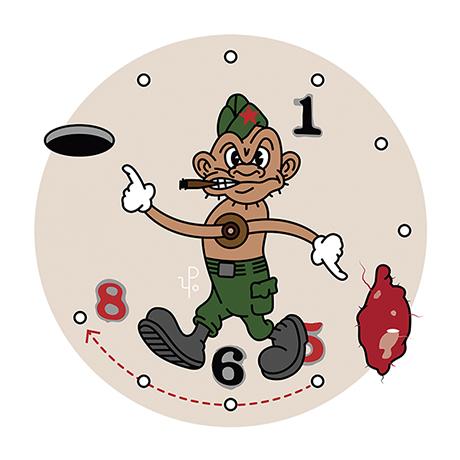
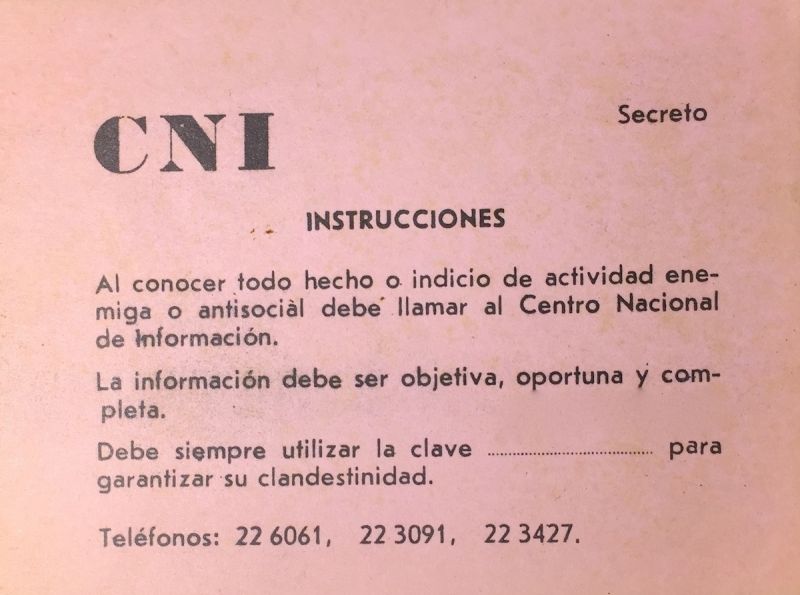
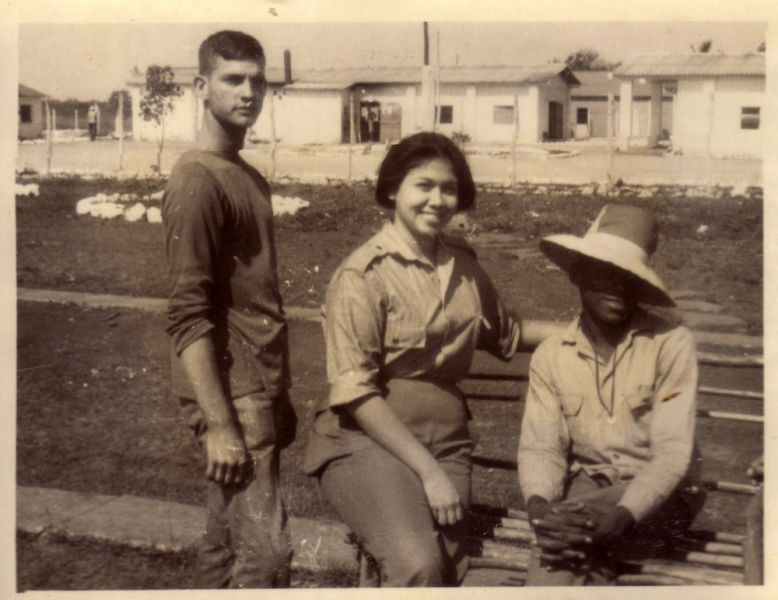
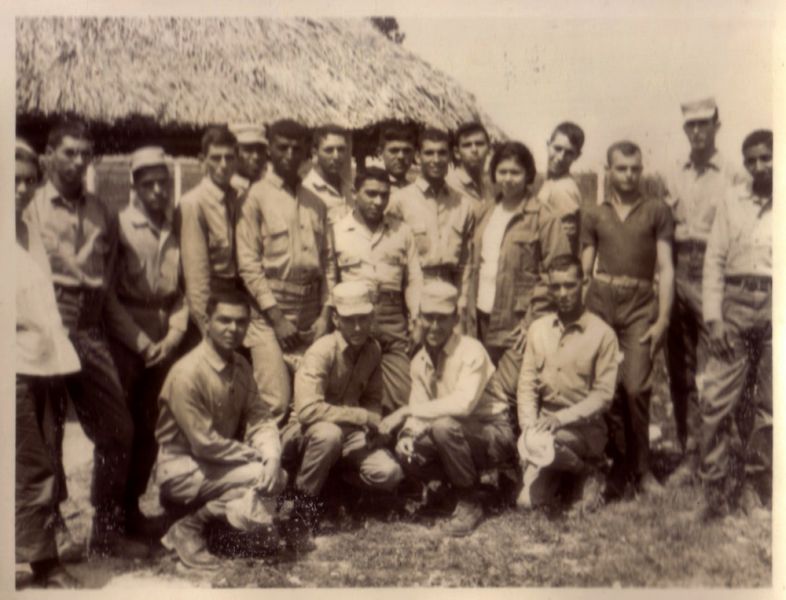
![Cover of Sin Tregua! [Without Truce], informational bulletin of the UMAPs political arm, No. 6, 1967. “Social hygiene is what this is called”](https://translatingcuba.com/wp-content/uploads/2016/02/umap-6-6.jpg)